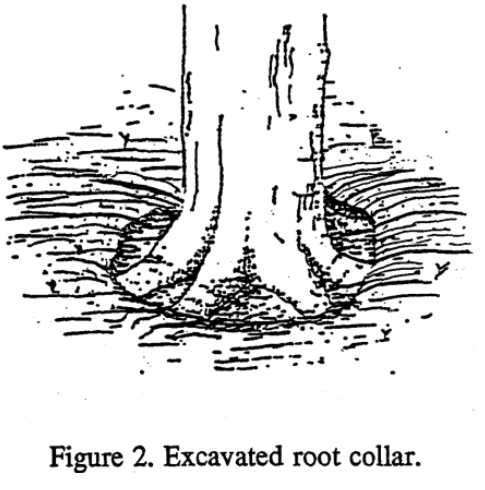Your tree’s root collar is the area where the roots join the main stem or trunk. This area is typified by a flare leading to the major roots.
 The root collar is part of the tree’s trunk. Unlike roots, the trunk is not specialized to resist constant soil moisture. The movement of oxygen and carbon dioxide in and out of the phloem (inner bark) is inhibited by this water. Over a period of years the lack of gas exchange will kill phloem cells. This interferes with the downward movement of food (photosynthate) to the roots, eventually leading to root dieback and reduced water uptake.
The root collar is part of the tree’s trunk. Unlike roots, the trunk is not specialized to resist constant soil moisture. The movement of oxygen and carbon dioxide in and out of the phloem (inner bark) is inhibited by this water. Over a period of years the lack of gas exchange will kill phloem cells. This interferes with the downward movement of food (photosynthate) to the roots, eventually leading to root dieback and reduced water uptake.
Root collars with declining phloem are more susceptible to infection and disease caused by certain pathogenic fungi, especially Phytophthora, Leptographium and Armillaria.
Often root collars are buried during landscaping projects when fill soil is distributed around the tree. When trees are transplanted, they may settle in the planting hole or be set too deeply. Some trees arrive from the nursery with excess soil against the root collar. Excessive mulch may also lead to death of the root collar. Mulch layers should not exceed four inches in thickness and should never be placed against the root collar.
 Symptoms of root collar disorders are often first evident as foliage yellowing, early leaf coloration and drop, and dieback in the upper crown. Some trees will show no symptoms at all prior to their death during a hot dry period of the summer. Secondary invaders such as canker fungi and insect borers often invade trees stressed by root collar problems. These cankers may cause sunken areas near the soil line.
Symptoms of root collar disorders are often first evident as foliage yellowing, early leaf coloration and drop, and dieback in the upper crown. Some trees will show no symptoms at all prior to their death during a hot dry period of the summer. Secondary invaders such as canker fungi and insect borers often invade trees stressed by root collar problems. These cankers may cause sunken areas near the soil line.
Soil should be removed from an area as large as possible around the trunk. A radius of six inches is the minimum excavation, which should be done. It is best if the slope angle of the excavated area is not more than 20°. Excavations should not injure roots over 1/4” in diameter. Adventitious roots over 1/4” should not be removed from the trunk since they may be providing substantial amounts of water and nutrients to the tree.
